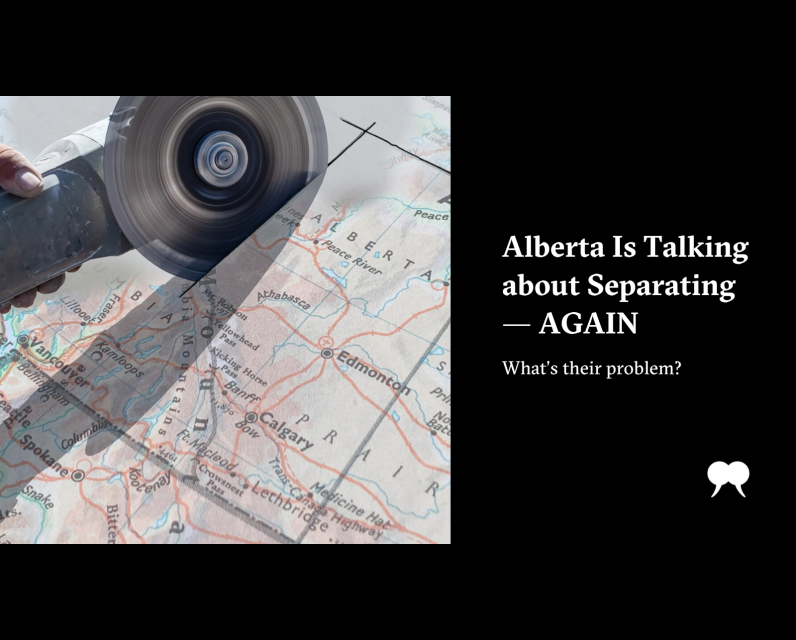Source Feed: Walrus
Author: Christina Frangou
Publication Date: June 6, 2025 - 06:30
Alberta Is Talking about Separating—AGAIN
June 6, 2025

Before the province even had a name, Alberta’s politicians demanded limits on the federal government’s power. “The new province in the West will not consent to be dictated to from Ottawa,” Calgary lawyer and senator James Lougheed said in 1904, as reported by the Weekly Albertan.
He was talking about education, but that sense of frustration with Ottawa has been a part of politicking in Alberta since the province joined Confederation in 1905.
According to the 1911 census, one in five Albertans came from south of the border, a figure much higher than the 3 percent reported across the rest of the country. Americans went on to dominate the United Farmers of Alberta, which formed the provincial government from 1921 to 1935. US investment then drove the early development of the oil and gas industry. Between 1955 and 1970, nine of the Calgary Petroleum Club’s presidents were American. The American influence on Alberta’s character has left its citizens wearing cowboy hats and boots, and also with a propensity for a “populist and anti-federalist” approach to government, says Nelson Wiseman, professor emeritus of political science at the University of Toronto.
The frustration with Ottawa came to a head in 1980 when prime minister Pierre Elliott Trudeau brought in the National Energy Program, which put price controls on Canadian natural gas and oil and routed tax revenues to the federal government. Then-premier Peter Lougheed (grandson of the earlier senator) announced that Alberta would reduce its supply of oil to the rest of the country and launch a legal challenge. Lougheed later became a driving force in adding the amending formula—which gave no province a veto but allowed dissenting provinces to opt out of amendments to the Constitution Act, 1982—and the notwithstanding clause to the Charter of Rights and Freedoms.
Throughout his battles with Trudeau, Lougheed remained committed to a united Canada. The same was not true of all Albertans. It was during this conflict that the independence movement got its first real foothold in the province. In 1982, the first separatist, Gordon Kesler, a rancher and rodeo competitor who ran under the Western Canada Concept party, was elected to the Alberta Legislature.
Since then, politicians from Alberta have pushed back against the federal government most aggressively when the Liberals are the governing party. In 2001, after Jean Chrétien won his third majority, six high-profile politicos from Alberta, including future prime minister Stephen Harper, sent an open letter to premier Ralph Klein. They called for building “firewalls around Alberta, to limit the extent to which an aggressive and hostile federal government can encroach upon legitimate provincial jurisdiction.”
We are now seeing an echo of that period—a Liberal government yet again in Ottawa, and Alberta trying to find a way to assert itself. But a few things are different this time round. For one, a segment within the separatist movement wants to join the United States. “That’s brand new, and that’s a combination of Trump’s threats of annexation combined with support of many conservatives of Donald Trump,” says Duane Bratt, professor of public policy at Mount Royal University.
For another, the push for independence appears to be coming from the top. “It is being ginned up by the government of Alberta. We’ve never had a separatist premier—a separatist government—before,” says Bratt.
Danielle Smith made her political career by befriending those most likely to see the federal government as a hostile power. In 2021, her soon-to-be chief of staff, Rob Anderson, co-wrote a document called the Free Alberta Strategy. It outlined a path to prepare the province for independence should Ottawa refuse Alberta’s demands. The following year, Smith’s first tabled bill as premier introduced the Alberta Sovereignty within a United Canada Act, which would allow the province to suspend the enforcement of federal regulations.
On April 29, 2025, with Mark Carney’s Liberal government barely a day old, Smith jumped into action. Her government introduced a bill that would loosen requirements for triggering a citizen-initiated referendum, opening the door to a vote on independence. She reiterated demands that she’d put to Carney before the election, including guaranteed access to a port for landlocked Alberta; an end to environmental regulation from the federal government; a ban on export taxes on Alberta products; and equalization payments to be switched to a per-capita basis.
And she upped the ante on the spectre of separatism.
“There is a large and growing number of Albertans that have lost hope in Alberta having a free and prosperous future as a part of Canada,” she said.
In tone, Smith sounds nothing like Lougheed, but plenty like Preston Manning, who led the Reform Party of Canada from 1987 to 2000. In the lead-up to the federal election, Manning published an article in the Globe and Mail, stating that if Carney were to win the election, he would become known as “the last prime minister of a united Canada.”
Bratt says “there’s no way” that Manning wrote the missive without Smith’s approval.
Barry Cooper, a political scientist at the University of Calgary who co-authored the Free Alberta Strategy with Smith’s chief of staff, says Smith does not “publicly support” independence—for the moment. If Ottawa refuses to “negotiate on, say, transfer payments,” Cooper says, “things will change.”
Smith insists she’s no backer of an Alberta exit from Confederation. “I personally still have hope that there is a path forward for a strong and sovereign Alberta within a united Canada,” she says.
Even so, her political career may depend on keeping separatists on her side. This spring, an Angus Reid Institute poll found that 19 percent of Albertans would vote to leave Canada, and another 17 percent said they lean in that direction. But support for separation is even higher within the ranks of the United Conservative Party (UCP), says Jared Wesley, a political scientist at the University of Alberta who studies Alberta separation. “You have to imagine yourself being the leader of a party where that’s your base, and she’s trying to thread the needle between being an outright separatist and being a full champion of Team Canada,” he says.
Her predecessor, Jason Kenney, a skilled political player, tried to keep the separatist movement appeased and failed. “She’s not known for that kind of tactical expertise, for internal party discipline, and there are signs that she is starting to lose control of her caucus, too,” says Wesley. One UCP MLA resigned from cabinet in February, citing concerns about whitewashing over health care contracts; another was kicked out of caucus for threatening to vote against the budget, and in April, a long-time party operative resigned, again citing corruption.
Smith is playing a high-stakes game that has put both her political future and the province’s on the table. No one knows how this ends, only that it may lead to a vote in which Albertans are asked whether they want to leave Canada. That’s when the province—and the rest of the country—will find out who’s bluffing.The post Alberta Is Talking about Separating—AGAIN first appeared on The Walrus.
The Village of Chase in British Columbia’s Interior has activated its emergency operations centre as a wildfire burns in the area. The village said in a statement that the nearby Neskonlith Indian Band issued an evacuation order because of the fast-spreading wildfire that was discovered Monday.
July 1, 2025 - 00:44 | | The Globe and Mail
Pitcher Max Scherzer's second start at Rogers Centre this season was far more successful than this first.
June 30, 2025 - 23:45 | Globalnews Digital | Global News - Ottawa
Vladimir Guerrero Jr. drove in three runs and Max Scherzer allowed two runs over five innings as the Toronto Blue Jays defeated the New York Yankees 5-4 on Monday night.
June 30, 2025 - 22:06 | Globalnews Digital | Global News - Ottawa



Comments
Be the first to comment